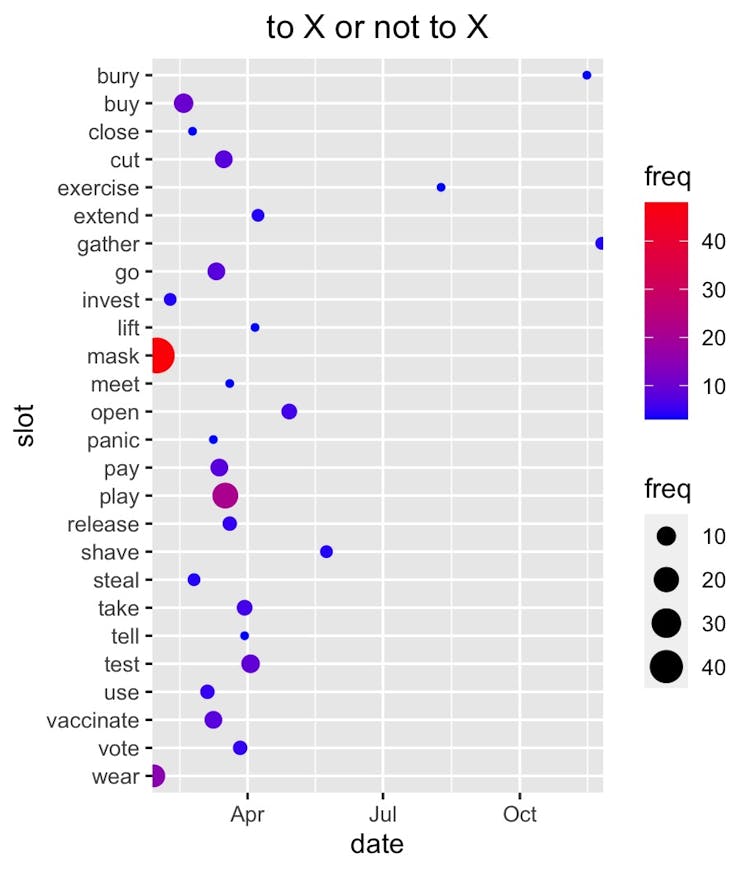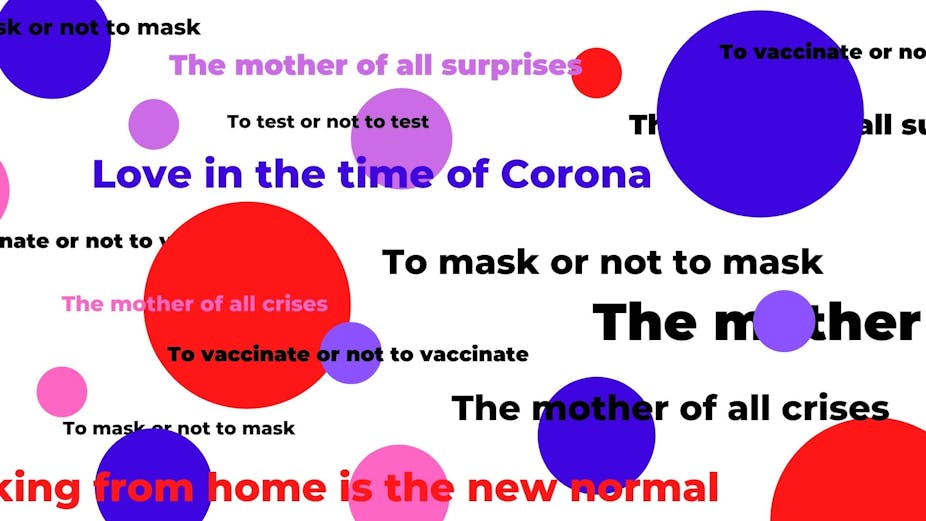During the COVID-19 pandemic, we have seen an explosion of new words and phrases in English (for example, covidiot) and other languages Coronaspeck in German to describe lockdown weight gain) that have helped us make sense of a period defined by social confusion and constant change, as well as global stagnation.
The scope of language innovation in relation to COVID is unprecedented and has clearly been reinforced by the extraordinary strengthening of digital connections between communities that the pandemic has brought about.
Language can be understood as a system of fixed set of rules or building blocks that can be used in a free and almost infinitely varied manner. One particular type of fixed linguistic creativity, where language users intentionally manipulate linguistic material for a creative effect, are linguistic “snowclones”.
A snowclone is a phrasal template with adaptable slots. It can be constantly replicated (or cloned) by switching some of the words that form it. For example, “X is the new Y”, “the mother of all X” or “to X or not to X”.
You’ve probably seen “love in the time of Covid” or read about how “working from home is the new normal”. These changeable phrases have captured the attention of writers during COVID as they needed to express new and unexpected meanings in a conventional manner that everyone can grasp.
Snowclone is the new cliche
The need for a narrower term for this sort of cliche was first pointed out by the British linguist Geoffrey Pullum on Language Log, a collaborative blog, in 2003. In connection with the template “if Eskimos have N words for snow, X surely have M words for Y”. Pullum declared the term “snowclone”, coined by economic academic Glen Whitman in his blog Agoraphilia, to be the winner in January 2004.
Snowclones have since become quite popular and are not only in focus in academic publications on linguistic creativity, but also in blogs which have devoted quite some time to exploring the entertaining features and types of such phrasal formulas.
You might find, for instance, blog posts exploring the frequency with which certain cities take up the slots in the snowclone “what happens in X stays in X” and how that provides a rough index of which places are more depraved than others. Unsurprisingly, Vegas comes up a lot but so do Dewey Beach (Delaware), the Florida Keys, Michigan, Mexico and Thailand.
Snowclones were originally identified and discussed online as “phrases for lazy writers” or “journalistic clichés”. It might be that these conventional formulas actually help some idle journalists to quickly complete or title their articles, but I see snowclones as creative devices that have helped journalists to disguise dramatic changes in a palatable and easy to comprehend template. In this way, they have helped readers to better digest social and economic shock.
Snowclones in the time of COVID
Two famous snowclones were investigated in the Coronavirus Corpus. Introduced in May 2020, this electronic corpus aims to become “the definitive record of the social, cultural and economic impact of the coronavirus (COVID-19) in 2020 and beyond”. It contains more than one billion words (growing by approximately 3-4 million words a day) from online newspapers and magazines published in 20 Anglophone countries.

In the two plots below, each dot marks the first date of use of the snowclone in the Coronavirus Corpus (horizontal axis) and specifies the word taking the slot (vertical axis). The dots get larger and closer to a purple or red tone when there is a high frequency of a particular type in the data (collected in late May 2021).
This first dot plot reflects the use of different types of the template “to X or not to X” to express new pandemic-related dilemmas from very early in 2020 (most appear first before April 2020). The higher frequencies seem to visibly capture the public debates which were gradually emerging as regards the use of a mask (“to wear or not to wear?”), the budding need for testing (“to test or not to test?”) and vaccinating (“to vaccinate or not to vaccinate?”), or whether certain sports events were going ahead (“to play or not to play?”)
The second plot focuses on the different versions of the snowclone “the mother of all X” in the Coronavirus Corpus.

We see that the template is very frequent in association with the word “invention”, and within the larger proverb “necessity is the mother of all invention”, which illustrates well the many ingenious adjustments that citizens had to apply to their usual ways of living for quite a few months. In the plot, we also see the reworking of familiar metaphors to refer to the pandemic (“the mother of all battles”), as well as more literal instances highlighting the extremely delicate situation: crises (“the mother of all crises”), pandemics, recessions and superspreader events.
All in all, the examples of snowclones presented here are only a very small illustration of how language creativity has bloomed under the sway of the coronavirus crisis. The creation and adaptation of new vocabulary have been apparent to most, but other types of linguistic creativity (such as snowclones) have also developed in the last 18 months. We have rarely had the chance to watch language usage mutate so clearly in real time.
Language is made up of a finite set of elements, but when people face new situations, they use their linguistic building blocks in new and creative ways to speak about new circumstances. We all had to get out of our routines and habits during the “corona crisis”. As in life, so in language.

